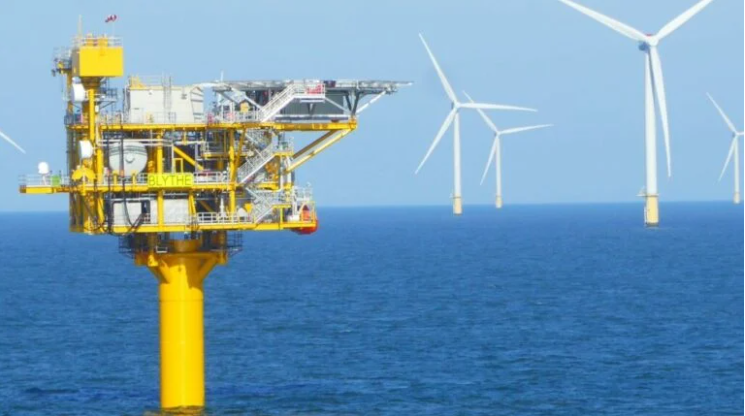
UK-headquartered IOG plc has brought on stream another well, as part of the Saturn Banks Project – Phase 1 in the Southern North Sea, boosting the UK energy market’s domestic gas supply.
Blythe platform; Source: IOG
The Blythe H2 well, which was spudded on Sunday, 5 March 2023 with Shelf Drilling’s Shelf Perseverance (former Noble Hans Deul) jack-up drilling rig, was drilled to the Basal Zechstein sequence in April 2023 when a potential delay to the previous timeline was revealed due to encountering an abnormally pressured gas and oil influx with associated drilling fluid losses while drilling through the Hauptdolomit formation within the Zechstein.
When May 2023 rolled in, the UK player confirmed that the drilling operations were continuing to the expected total depth of around 13,000 ft MD while the first gas from the Blythe H2 well was anticipated by the end of 2Q 2023. The following month, the firm announced plans to bring the second Blythe production well online in June 2023, despite losing 34 days to the well control event.
In an update on Tuesday, 13 June 2023, IOG revealed that the first gas was delivered from the Blythe H2 well into the Saturn Banks Reception Facilities and Bacton terminal on 12 June 2023. This well has been brought on stream three months and one week from the spud date, versus initial guidance of approximately three months, despite 34 days lost to the well control event.
According to the company, the well is in the ramp-up phase towards an expected initial maximum rate. The maximum well test dry gas rate was 22.8 mmscf/d and 280-336 bbl/d condensate at the export pipeline pressure of 1250 psi. IOG explains that the H2 flow appeared to be choked back below the levels indicated by reservoir properties by a downhole restriction during testing.
The firm’s analysis of pressure and temperature data from the well test indicates a downhole restriction above the reservoir is choking back production. As the pressure build-up data since the test indicates reservoir permeability is in line with pre-drill expectations, IOG concludes that this supports the view that the issue is mechanical rather than reservoir driven.
Furthermore, the analysis of combined pressure and temperature data infers that a potential cause for the restriction may be a partially activated downhole valve. Bearing this in mind, the UK firm intends to allow the well to produce at initial rates until specialist downhole equipment arrives on the rig within the next two weeks to assess and, if necessary, manually actuate this valve. Based on IOG’s data, this intervention would likely take up to a week at an estimated incremental cost net of around £0.5 million (about $0.63 million).
Rupert Newall, IOG’s CEO, commented: “IOG’s Drilling, Operations, and Engineering teams have done an excellent job to bring the Blythe H2 well onstream within one week of our initial three-month guidance, despite losing over a month to the well control event. Strong collaboration with Petrofac (well operator), Shelf Drilling (rig contractor), ODEAM (infrastructure duty holder) and Perenco (terminal operator), among others, has enabled safe and efficient execution of this important well.
“We are expediting equipment to the rig to resolve the apparent downhole mechanical blockage, which if successful could increase H2 flow rates by around month-end to the 30-40 mmscf/d range that we guided pre-well. In addition, we continue to work very actively on next steps beyond H2 and expect to provide further updates shortly.”
As the H1 well was shut in as planned during the final H2 HUC, IOG highlights that its plan remains to produce initially from H2 only, to flush formation water out of the Saturn Banks Pipeline System and reduce associated opex. Following a shut-in period to allow the water levels to re-equilibrate, the plan is to reopen H1 periodically at lower rates to flow gas and condensate with limited water production.
The IOG-operated Saturn Banks Project – Phase 1 – sanctioned in October 2019 – covers Blythe, Elgood, and Southwark fields in the UK Southern North Sea. The first two fields – Blythe and Elgood – were brought on stream in mid-March 2022. IOG holds a 50 per cent stake in this project and its partner, CalEnergy Resources, holds the remaining 50 per cent.
IOG calls for return of small fields allowance
Moreover, IOG welcomed the introduction of price floors for the Energy Profits Levy (EPL), whereby oil must remain below $71.40/bbl and gas below 54 p/therm ($40.7/boe) for six consecutive months in order for the EPL to be suspended. However, the company expects the actual impact to be minimal given the particularly low gas floor and the requirement for both gas and oil floors to be met.
“The change looks likely to favour larger integrated energy businesses with international production and LNG trading capabilities at a time when the greater focus is needed on developing domestic low-carbon gas supplies to displace higher carbon intensity LNG from overseas and improve the security of supply,” outlined IOG.
IOG further underscores that the North Sea is a relatively mature basin while the UK gas market is increasingly dependent on imports. With this in mind, the firm continues to advocate for the reintroduction of a small fields allowance, which would “specifically help to stimulate much-needed further investment in lower carbon intensity domestic gas fields to displace imported LNG.”




